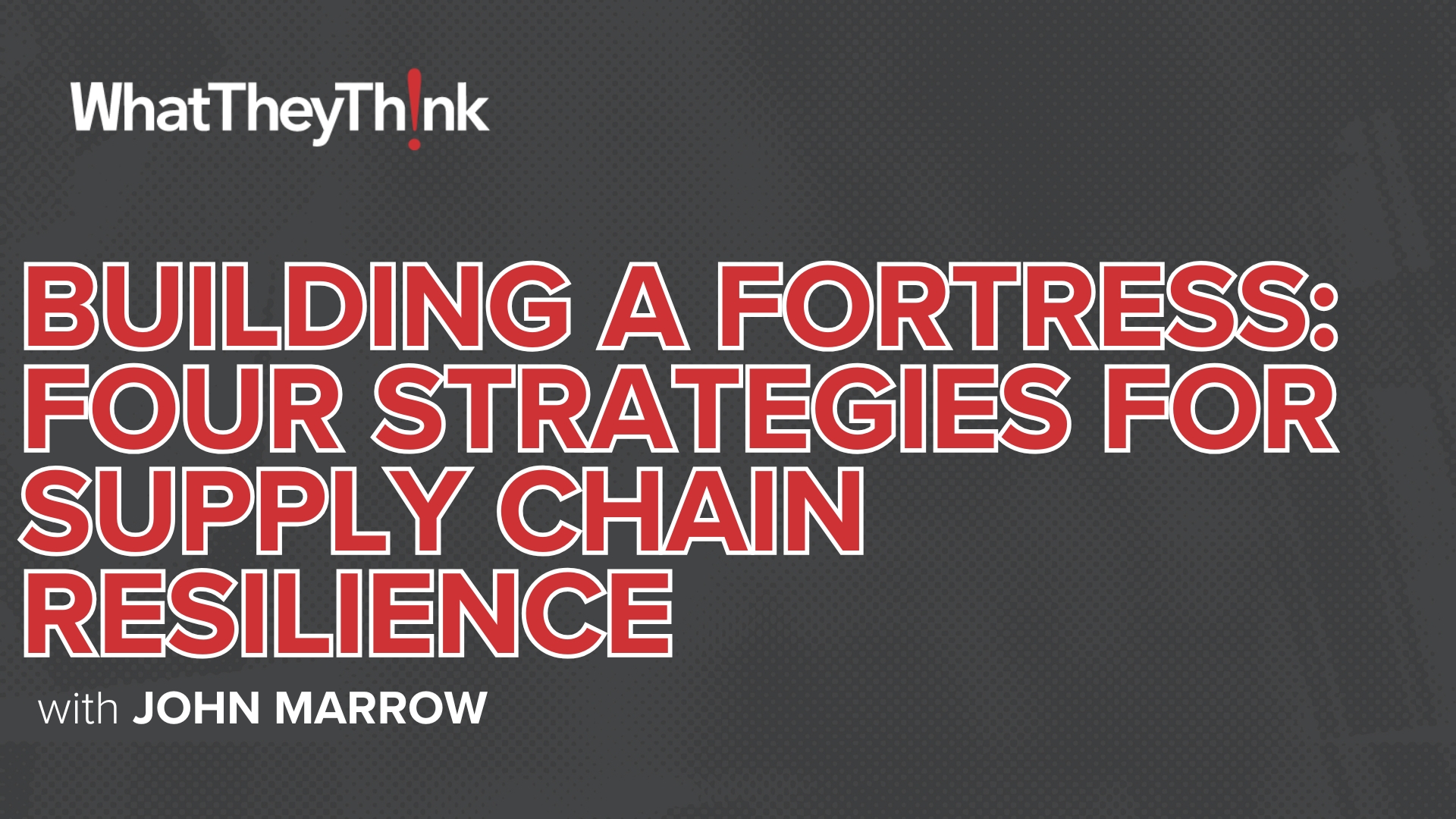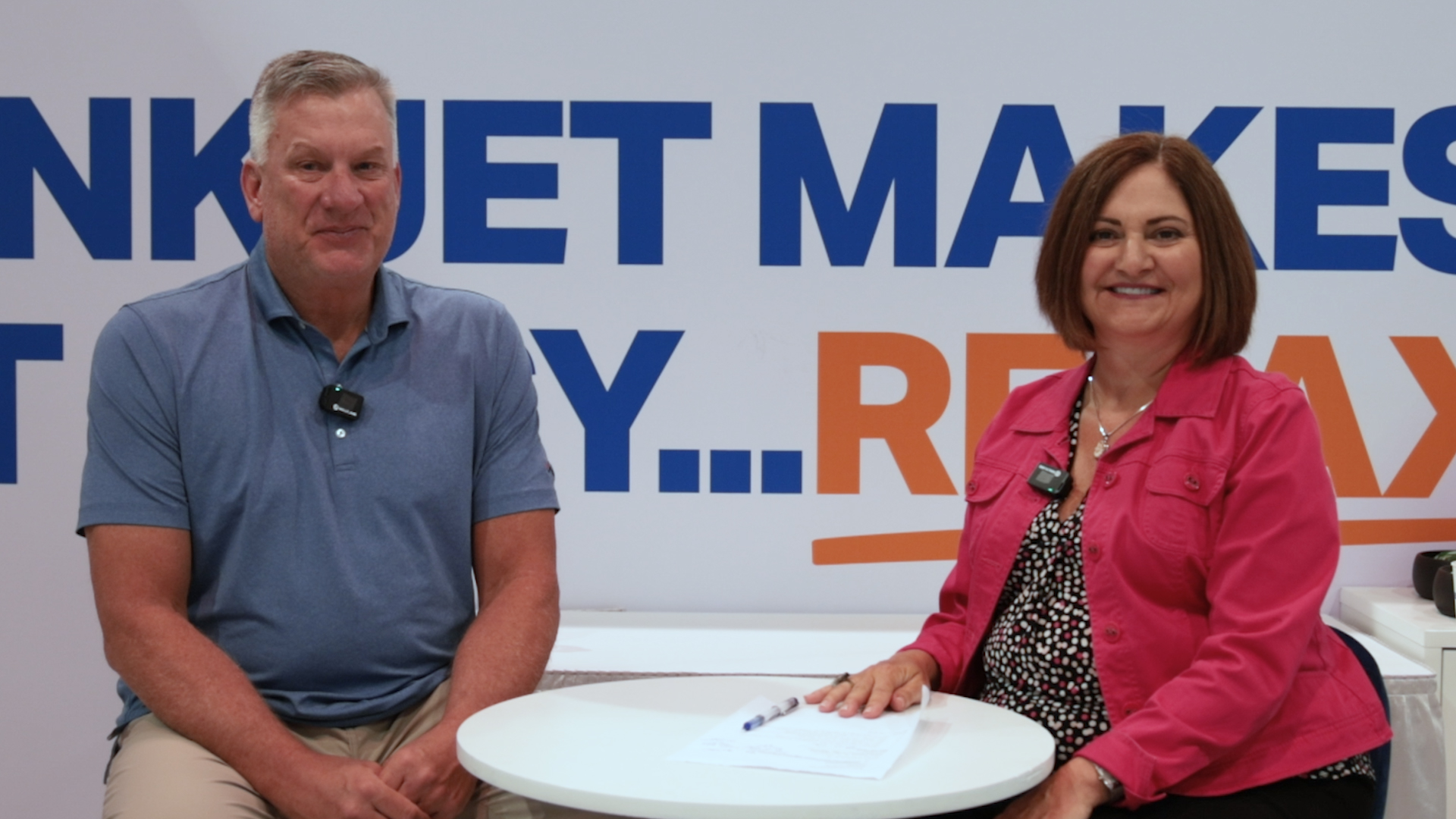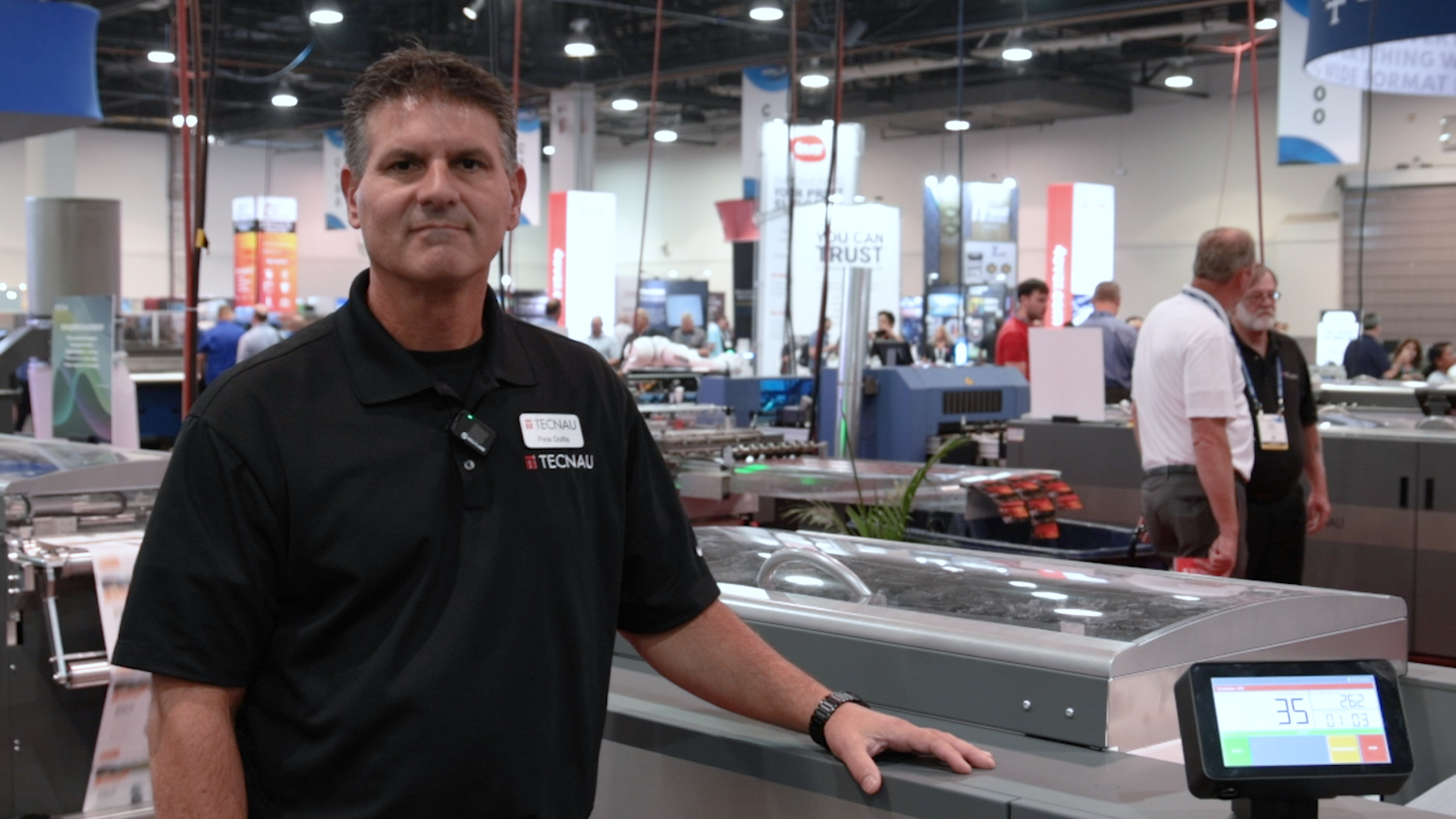Commentary & Analysis
Displaying 1801-1900 of thousands of articles
Insight You Need. Analysis You Trust.
Get the trusted insights you need to understand our evolving industry and emerging trends. Become a Premium Member.
Converted Paper Product Manufacturing Employment—2010–2018
According to County Business Patterns, in 2010, there were 253,464 employees in NAICS 3222 (Converted Paper Product Manufacturing establishments). Employment in this category dropped abruptly in 2012, then remained somewhat stable over the course of the decade and reaching 245,579 in 2018. In macro news, the American Institute of Architects (AIA) monthly Architecture Billings Index (ABI) show increased demand for architectural design services, good news for the signage industry.
Expanding Into New Markets: Manchester Print Services Goes from Wide Format to Interior Décor
Manchester Print Services in the UK is one of a growing number of companies driving new business models in the textiles industry, including digital production of interior décor, as well as specialized textile printing for events, exhibitions, and retail display.
Overcoming Implementation Issues
In his fourth of six articles dealing with improving how we get things done, Wayne Lynn looks at getting past issues that delay and potentially stifle the implementation of goal-supporting business decisions. Leaders and their teams need to develop and support the Inventive mindset. Read on to learn more.
Inkjet Uncovers New Opportunities for Print in a Digital Era
Although the print industry is still reeling from the ongoing effects of the pandemic, direct mail communications have seen a resurgence because of their tactile nature and ability to establish a physical connection. This article explores how print service providers can leverage inkjet technology to capitalize on new opportunities in print.
Cherchez LaPlume: A Massachusetts Printer Thrives Despite Challenges
In the past three years, Lawrence, Mass.’s LaPlume & Sons Printing experienced a gas explosion and then the pandemic—but then this 85-year-old family business has faced its share of challenges over the decades and has managed to change with the times.
Our Unique Attachment to Paper
The products we produce are on paper, so paper is part of our business. Yet we need to break our attachment to the analog (paper) as a tool for running a dynamic custom manufacturing business.
Gartner: Marketing Budgets Are Not Bouncing Back to Pre-Pandemic Levels
Even as CMOs’ 2020 marketing budgets were being slashed as a result of the COVID-19 pandemic, CMOs were hopeful that those budgets would bounce back in 2021. But Gartner’s just-released “CMO Spend Survey” tells a different story. Not only are budgets not bouncing back, but they have dropped to the lowest level in the history of the survey. Is there any good news for PSPs in here?
What’s Your Sales Succession Plan?
One consequence of the pandemic has been an increase in employee turnover, especially in sales. Pat McGrew talks about how print businesses can cope with top sales talent exiting the company.
New Campaign Uses Signage to Promote Bicycle and Pedestrian Safety
Bikeatoga, a non-profit organization that promotes bicycling and bicycle safety in Saratoga Springs, N.Y., has launched a lawn signage campaign to help prevent vehicle-bicycle accidents.
Paper Prices Climb: How to Warn Your Customers Early
Printing costs are going up, and we need to start letting customers know prices will too. Customers need advance warning—no one likes surprises. Contributor John Giles advises you to be proactive and tell your customers, particularly your top customers, about the pending increases.
Modern Litho Continues on Growth Path, Pursuit of Innovation
Over the last several years, Jefferson City, Mo.-based Modern Litho has experienced growth both organically and through acquisitions as it expands its footprint within Missouri. In this interview, Jeff Davidson discusses the company’s strategy, how acquisitions are key to its growth and diversification, and its latest investments in IT infrastructure.
Reanimate the Customer Experience
How do you evolve your business and imbue your culture with a customer-centric ethic that actually modifies your organizational DNA? Preston Herrin offers four steps to becoming a customer-experience-driven company.
European Print Industry Snapshot: Denmark
In this bimonthly series, WhatTheyThink is presenting the state of the printing industry in different European countries based on the latest monthly production numbers. This week, we take a look at the printing industry in Denmark.
June Shipments: A Lateral Move
June 2021 printing shipments came in at $6.65 billion, unchanged from May. We usually see declines from May to June, but at least the lateral move has halted two months of declining shipments.
Around the Web: Pressure Patch. Grape Graphene. Step Signs. Code Column. Corrugated Construction. Pall Pebbles. Emphasis Enigma. Travel Trauma. Fowl Fabio.
A new wearable patch can monitor blood pressure. New graphene paper can extend shelf-life of fruits. Calorie-counting stair signage. A first-person essay written by a QR code. The new “packaging real estate boom.” Why is the English language as erratic and haphazard as it is? Turning cremains into decorative pebbles. How fast can you type the alphabet? The 1962 Tanganyika Laughter Epidemic. How much trouble is the travel industry in? Remember that time when a goose collided with Fabio’s face? All that and more in WhatTheyThink’s weekly Delta variant miscellany.
Paper Suppression: Will It Be the Final Nail in Transactional Mail’s Coffin?
Everywhere you look, whether online or off, enterprises are sending customer communications that beg, plead, and sometimes even force consumers to go paperless. Although COVID-19 has accurately been dubbed “the great accelerator,” ongoing market shifts probably won’t prove to be the final nail in the coffin that represents the death of printed bills and statements.
Carpet Printing Technologies Compared: How Have They Evolved and at What Cost?
With so much emphasis being placed on customization of interior and home décor enabled by digital printing technologies, can we even customize our carpets now? Textiles expert and WhatTheyThink contributor Debbie McKeegan shares this Texintel guest post by Bob Balings of Bob Mats B.V., which highlights different carpet printing technologies and their pros and cons, with lots of great advice about selecting the right technology for your work.
True Print Personalization: Is It All Talk and Little Action?
To what extent is this industry merely talking about relevance-based personalization and to what extent are we actually doing it? Insights from Who’s Mailing What!, a national database of direct mail, raises some interesting questions.
Understanding the Human Resistance to Technology Change
Projects like a Print MIS/ERP transition always create resistance to change. The most common resistance to change is fear but it generally is disguised under a barrage of logical objections.
Johnson’s World: Poop on the Playground
You offer great quality, terrific service, and competitive prices, yet some prospects still won’t work with you. Why? Steven Johnson uses a colorful analogy to show how customer disinterest can come from some unexpected places.
Printlink Finds the FireJet 4C Color Inkjet Press Ideal for Envelopes
Feeding envelopes through a printer is not necessarily an easy task, especially since there are so many sizes, configurations, and variations in thickness—even batch to batch. Yet Printlink has found an exceptional bespoke press solution that highlights what can be accomplished with production inkjet.
What Does the Post-COVID Future of Apparel Look Like?
We’ve been speculating about how the textiles and apparel industry will come out of the pandemic—how much will change, how quickly, and how much will remain the same? To help with this thought process, the School of Industrial and Labor Relations at Cornell University has published a study entitled "Repeat, Repair or Renegotiate? The Post-COVID Future of the Apparel Industry." We summarize the results in this article.
The Target Report: Packaging Industry Consolidation in Every Direction—July 2021 M&A Activity
Fort Dearborn & Multi-Color Join Forces, Mt. Royal Expands, and more…
Around the Web: Dining Documents. Felt Foods. Potato Packaging. Graphene Gold. Poster Portal. Microscopic Matter. Ant Aficionado. Neat Knife. Space Server.
The history of the restaurant menu. A “textile artist” specializes in food. French fry packaging made from discarded potato peels. Does it surprise you that graphene played a role at the Olympics? Changes are coming to Google Drive—consider yourselves warned. Pop Charts sells very cool infographic posters. Cornell researchers capture the highest-resolution image of atoms ever seen. An eight-year-old “entrepreneurial ant dealer.” Ron Popeil passes away. SpaceX is looking for a spaceport bartender. All that and more in WhatTheyThink’s weekly Olympic miscellany.
Internet Publishing Employment—2010–2018
According to County Business Patterns, in 2010, there were 90,892 employees in NAICS 51913 (Internet Publishing and Broadcasting and Web Search Portals). Over the course of the decade, employment in this category grew steadily to reach 275,875 in 2018. In macro news, real GDP increased at an annual rate of 6.5% in Q2 2021.
CMYUK Launches the “Creatives In Residence” Live and Worldwide Design Competition
One of the critical needs in the textiles and apparel industry is attracting new talent. CMYUK is helping address this need by launching a worldwide competition to recognize emerging talent. Its “Creatives in Residence” program will give two young surface designers and one talented videographer an outstanding opportunity to undertake a six-month placement at CMYUK’s advanced digital training and demonstration facility in Shrewsbury in the UK. While this might seem UK-centric, it is a worldwide opportunity. If you know a talented young person that would like to participate, please let them know about this opportunity! Learn more...
Leveraging Direct Mail to Engage Multiple Senses
Because electronic messages substantially outnumber printed communications, direct mail is now the less cluttered channel. Electronic communications also fall short of well-designed printed communications in terms of tactile impact. This article explores how marketers of printed communications can use the sensory elements of direct mail to their advantage.
The Goal of Automation Drives Process Improvements
Automation is the sexy sales and marketing term. Process improvement is where the magic happens. Keep your reality hat on and think about automation at the discrete task level of your business process.
Gartner: Marketing Budgets at All-Time Low, but CMO Council Finds the Opposite
As the U.S. economy continues to bounce back, “state of marketing” surveys are giving conflicting pictures. One says marketing budgets are falling. Another says they are rising. What to make of this conflicting information?
Missing the Signs—Post-Pandemic Signage Largely MIA as Everyone Returns to Normal
Navigating the post-pandemic world in the early days of the reopening could be confusing, as there was little signage that indicated a particular location’s policies regarding mask-wearing, etc. Still, some demand for post-pandemic signage remains, although the major opportunities for sign and display graphics producers were mostly fleeting.
Association Insights: PRINTING United Alliance
PRINTING United Alliance is a member-based printing and graphic arts association based in the U.S. The Alliance team provides economics and market trend insight, education, certification, events, human resources services, the latest legislation affecting our industry, environmental, and health and safety leadership. The Alliance partners with leading industry organizations that echo its mission in serving professionals and their companies across market segments with current, usable resources, both locally and nationally.
Beyond Braille: The ABCs of ADA Signage
Wayfinding and other kinds of interior graphics are good opportunities for signage and display graphics providers. However, it is essential to have an understanding of the requirements for signage to be compliant with the Americans with Disabilities Act (ADA)—and how some of those requirements have changed post-COVID.
From Fuji Xerox to Fujifilm
2021 marked the year that Fuji Xerox become FUJIFILM Business Innovation and started launching their own product range. While still supplying most print engines to Xerox, FUJIFILM Business Innovation is set to become a major digital printing player on its own. Get ready for an emerging major player in digital print.
Around the Web: Creepy Codes. Fast Fashion. Cookie Cache. Running Robot. Crazy Crutches. Tennis Trivia. Zipping Sipping. Pricey Potatoes. Human Hamster.
Fats Domino toured with Scitex equipment? QR codes could be poised to raise privacy concerns. Graphene goes skiing. Is more expensive clothing necessarily more ethically produced? Keep your Oreo cookies away from your kids by using disguised packaging. How fast can a robot run a 5K? Pogo stick crutches, to make your rehab even more challenging. Philosophical CAPTCHAs to make your logins more challenging. Why are tennis balls yellow? A reusable silicone straw that unzips for easy cleaning. The world’s most expensive French fries. Florida man attempts to run on water from Florida to New York in a giant hamster wheel. Cicada killer wasps! All that and more in WhatTheyThink’s weekly Olympic miscellany.
June Graphic Arts Employment—Continuing to Get a Little Better
In June 2021, all printing employment was up +0.1% from May, production employment up +0.7%, and non-production printing employment down -1.2%.
Implementing a Vertical Market Approach: Benefits and Opportunities
As opposed to a horizontal market approach (which involves developing a specific product offering that touches many industries), a vertical market approach involves serving specific customers with specific needs. This article explores how implementing a vertical market strategy can help you recognize new and existing opportunities.
Exquisite Italian Silks from Mantero Seta Printed to Perfection with Epson Monna Lisa Digital Technology
Throughout history, silk has been recognized as one of the most, if not the most, exquisite and luxurious fabrics available. Now fabric printers are having huge success with digital printing of this glorious textile. In this article, textile expert and WhatTheyThink contributor Debbie McKeegan shares an example from Italian firm Mantero.
Five “Feel Good” Environmental Stories from the Paper and Packaging Industry
Paper and packaging companies are not only consumers of natural resources, but they are striving to be protectors of them, too. Here are five “feel good” stories about how members of the paper industry are doing their part.
Your Business Constraints and Print Business Software
Constraints are real. You can feel limited by them or you can decide to work with them in a way to maximize your results. No business is without constraints. With print software, humans and existing software are critical constraints to embrace.
The Five Steps to Managing Pricing—Part 2
If you are struggling with setting prices or trying to decide when it’s time to change prices, Pat McGrew offers some starting points with this two-part series on five steps for managing pricing. This second part involves looking not just as the products you sell, but the services, too, and then reviewing and executing your pricing plan.
European Print Industry Snapshot: Sweden
In this bimonthly series, WhatTheyThink is presenting the state of the printing industry in different European countries based on the latest monthly production numbers. This week, we take a look at the printing industry in Sweden.
Pivot! How to Strategically Pivot Your Business Amid Uncontrollable Change in Four Steps
Pandemic and other forms of uncontrollable change can be detrimental for businesses. However, to offset initial disruptions and potentially larger, more long-term implications when hit with the unexpected, leadership at organizations must act swiftly and rally their team. Guest contributor Burke Cueny, VP of Marketing for Alliance Franchise Brands, explains how multiple departments and business units can work together to overcome the crisis.
Sustainability in Textile Finishing
We’ve written a great deal about sustainability—or the lack thereof—in textiles and apparel on this site. In this article, we highlight some of the less discussed but equally important textile finishing technology that is driving sustainability in the industry
Assorted Publishing Employment—2010–2018
According to County Business Patterns, in 2010, there were 10,166 employees in NAICS 511199 (All Other Publishers). Over the course of the decade, employment in this category steadily declined to bottom out at 4,999 in 2018. In macro news, last year’s “official” COVID recession lasted only two months, according to the NBER.
Around the Web: Reading Rollercoaster. Popular Pen. Author Avatar. Sentimental Software. Will’s Words. Car Cologne. Nerdy Neckwear. Beefheart Beer. The Martin Luther Insult Generator.
Book sales may keep increasing…or not. A quill-like pen is a Kickstarter hit. A scholarly paper was co-authored by a dead friend in a dream. Do you remember The Print Shop pre-Mac design application? How many words did Shakespeare invent? Batteries need help…graphene to the rescue! A gasoline-scented cologne. A woman uses signage to accuse her cat of robbery. The Bow TIE: the geeky accessory you know you want. Two words: meth trout. All that and more in WhatTheyThink’s weekly space-bound miscellany.
Packed with Print, Color, and Creativity, Richard Quinn Delivers AW21 Fashion Through a Cinematic Lens
Fashion week on film? Richard Quinn unveiled this unique approach to debuting a new collection at the recent AW21 collection at the Electric Theatre, London. Is this a sign of what's to come from other designers? It would seem it is partly the result of the many things we have learned about virtual events and digital technology during the pandemic.
Using Print to Reach Younger Consumers
The oldest members of Generation Z will turn 24 this year, and Millennials are now fully entrenched in their adult lives. These groups wield a tremendous amount of influence and purchasing power, so it’s more important than ever to reach them. This article explores how younger consumers perceive print and considers how printed communications can be used to get their attention.
QR Codes Are Fueling the Growth of Augmented Reality
Until recently, growth and excitement around augmented reality (AR) has been limited among printers since the barriers to entry were high, and other than for SnapChat filters and niche applications (such as gaming), few consumers were using it. Even as AR experiences became more robust and effective, they required an app, and marketers found that people don’t want to download apps. Now AR has developed a symbiotic relationship with QR Codes, and that changes everything.
The Cult of “Busy-ness” in Your Print Business
Being busy doesn’t equate to business success. Is your busy-ness leading you in the right direction? Or are you being led by your inputs? Prioritization takes uninterrupted time and discipline, it results in your activities having strategic direction.
Product Spotlight on FUJIFILM Samba JPC®
Most people familiar with production inkjet printing are aware of the FUJIFILM Jet Press® 750s (marketed as JPRESS in the U.S.) and the FUJIFILM DIMATIX Samba printhead used in that press. This article by Inkjet Insight’s Elizabeth Gooding discusses the capability of Fujifilm’s Samba JPC technology to meet the evolving needs of system integrators and OEM customers.
Textile Tech: Are You Prepared for Change in Textiles and Apparel?
New players are introducing new technologies for textile and apparel production and are poised to up-end the industry. Upheavals in the supply chain and rapidly changing consumer demands are starting to increase a sense of urgency, and more brands are looking seriously at how to effectively work on-demand or made-to-order manufacturing into their go-to-market processes.
Six Habits of Productive Printers: Are You Ready to Re-Emerge from the Pandemic?
During the pandemic, profitable printers had a shared characteristic: they were proactive in selling and didn’t wait for customers to come to them. Contributor John Giles looks at six habits that allowed printers to be profitable during the pandemic.
Preserving the Memory of John Wayne: SpeedPro Dallas Was Declared Winner of the 2020 Project of the Year Award
SpeedPro Dallas was recently announced as the 2020 winner of the prestigious SpeedPro Project of the Year award for its masterful work on behalf of “John Wayne: An American Experience.”
Around the Web: Paper Pigments. Athletic Air. Graphene Growth. Modern Medicines. Stamp Cipher. Tape Technology. Music Mural. Cover Catastrophes. Reflective Reindeer. Distasteful Dessert. Taco Trade.
Electronic paper can now have as many colors as an LCD display. The US Olympic Team will sport wearable air conditioners. What will be in the medicine cabinet of 2030? Decode the latest Forever Stamp. A roll of tape featuring programmable QR-like codes. A repository of horrible sci-fi book covers. Painting reindeer antlers with reflective paint to prevent traffic collisions. A treadmill for hamsters. Mac and cheese ice cream, for some reason. McCormick is hiring a “Director of Taco Relations.” All that and more in WhatTheyThink’s weekly miscellany.
Shipments: An Evening Out
May 2021 printing shipments came in at $6.59 billion, a slight downturn from April’s $6.87 billion, and the second consecutive month of decline, but is consistent with the pattern we have been tracking over the past five years.
The Motivation to Get Things Done
Decisions are not made in a void. They serve multiple purposes but the focus of this article is on stimulating action that moves us toward the accomplishment of goals. Last month we looked at the subject of approaching decisions in a structured way and in a way that used both sides of the human brain. The point was to make the best possible decision using what we know about how the brain works and how each side works to balance and inform the other. This month we look at finding and ensuring that the necessary motivation is in place for successful implementation of decisions and achievement of our goals
New Beginnings and Future Opportunities in Digital Print
In his inaugural submission to WhatTheyThink, Keypoint Intelligence’s Carl Doty contemplates new beginnings and future opportunities for growth in the printing industry.
Graduate Fashion Week: An Incredible Display of Resilience and Creativity
It has never been more important to shine a light on the achievements of students graduating with expertise in the textiles and fashion industry. Like many other industries, finding new talent is difficult. Textiles expert and WhatTheyThink contributor Debbie McKeegan shares the story of one award-winning graduate we hope will be an inspiration to future generations of students who might consider careers in textiles and apparel.
Turning QR Codes into Print Work
Why has one QR code usage gain traction when others haven’t? What lessons can we learn from it? Can QR code use be turned into further print work, even if the code itself “steals” certain types of business?
Print MIS Product Spotlight: EFI’s Midmarket Print Suite
This Print Software Product Spotlight looks at EFI’s Midmarket Suite. EFI’s “suite” approach to software solutions essentially pre-packages a group of products that already work together to solve end-to-end workflows.
European Print Industry Snapshot: Czech Republic
In this bimonthly series, WhatTheyThink is presenting the state of the printing industry in different European countries based on the latest monthly production numbers. This week, we take a look at the printing industry in the Czech Republic.
The Five Steps to Managing Pricing—Part 1
If you are struggling with setting prices or trying to decide when it’s time to change prices, Pat McGrew offers some starting points with this two-part series on five steps for managing pricing. This first part involves understanding your costs and your current pricing.
Stick it There: A Consumables Applications Photo Gallery
Variable-temperature graphics installation. Vaccine site graphics. Outside art exhibits. Home décor. Superbowl graphics from the Before Times. In this photo gallery, we highlight some recent projects that users have produced using a variety of consumables types, from labels, to vinyls, to fabrics.
Increasing the Value of Your Business: Ask Yourself These Key Questions Before You Sell
Print businesses often don’t sell because we don’t prepare them for sale. Contributor Tom Crouser offers tips for maximizing the value of a business above and beyond the company’s asset value.
The Target Report: Apollo Trades Textbooks for Wallpaper & Pillows—June 2021 M&A Activity
Shutterfly acquires Spoonflower, Cathedral expands, and more…
How Direct to Consumer is Changing Retail
Direct-to-consumer retail for apparel, once the domain of upstarts, is now being more seriously pursued by larger brands, a move that has been accelerated by the pandemic. What does this mean for brands and retail? Is another upheaval coming?
Greeting Card Publishers—2010–2018
According to County Business Patterns, in 2010, there were 10,258 employees in NAICS 511191 (Greeting Card Publishers). Over the course of the decade, employment has been up and down, reaching 13,690 in 2018. In sort of macro news, Las Vegas tourism traffic rose substantially in May 2021, as conventions were poised to reopen.
Around the Web: Paper Press. Tricky Typography. Excellent Electrode. Problematic Poultry. Silk Sensors. Augmented Art. Bottle Boards. Fireworks Fail.
A meticulously detailed paper model of a Heidelberg letterpress. “Algorithmic typography.” Graphene’s latest triumph. Birds aren’t real!! A new approach to wearable tech. An outdoor art installation is all AR-based. Cutting boards made from upcycled bottlecaps. A candy-pushing robot will stalk you in supermarkets. A model of Jabba the Hutt’s internal anatomy, for some reason. All that and more in WhatTheyThink’s weekly miscellany.
Adobe Expands Presence in Textile Design with New Creative Alliance
Adobe announced a creative alliance with Aquario Design and NedGraphics, two elements of the textiles portfolio of FOG Software Group, a division of Constellation Software. The alliance was announced by Adobe’s Mike Scrutton at the Smithers Digital Textile Printing conference underway in Arizona.
Five Reasons to Adopt Dye Sublimation: Discover New Opportunities for Growth
The textile manufacturing industry is on the cusp of dramatic change, driven by increased focus on restructuring fragile supply chains and growing consumer demand for more sustainable practices. Learn why heat transfer dye sublimation fabric printing can help meet these challenges by enabling responsive on-demand production of textile-based products.
Hybrid Workplaces: Having Your Cake and Eating It Too?
As is the case with many other things, the COVID-19 pandemic brought about many changes to the modern workplace. During the lockdown phase, many discovered that remote work was sometimes just as productive as work performed in an office. When we come out on the other side of the pandemic, what will the workplace of the future look like? This article explores the benefits—and possible pitfalls—of a hybrid workforce.
Looking Ahead with HP: HP’s GM Shares Insight and His Outlook for Production Inkjet Printing
Carles Farre, vice president and general manager, HP PageWide Press, talks about his background, current role, and views of the future of HP’s production inkjet business and the industry at large, including both commercial and corrugated applications.
Buying Strategic Software Features
A strategic feature of software is a value driver that generally has prerequisites in order to reap the benefits of the feature. The sales process generally skips the prerequisites (for obvious reasons). It is your responsibility as the buyer to understand precisely what it will take to reach the potential.
The Unboxing Experience: What’s Old Is New Again
Recently, Keypoint Intelligence released data from a new vertical market survey that reflects how a classic concept—unboxing—has become today’s news. No company illustrates the power of unboxing more than Apple.
Shaped by the Pandemic: Online Print in Germany
Online print made rapid progress in the last few years, and the country with the most advanced market for online printers is probably Germany. Needless the to say, that the pandemic did affect online print greatly as well. This article by European section editor Ralf Schlözer offers some insight on the effects and outlook.
Sharp/NEC and Avery Dennison Team Up for New Digital Window Graphics
ActiveScene is a projection system from Sharp/NEC combined with an “active” window film from Avery Dennison that can turn any window into dynamic digital signage.
Digital Schmigital: Who Hearts Offset Printing?
Literally trillions of printed pages still are reproduced worldwide each year using traditional offset press technology—not to mention “newer” offset product applications such as door hangers, pocket folders, and packaging. Contributor Mark Vruno looks at the latest developments in offset equipment.
Smooth Sailing in the Production Process: How to Ensure Your Artwork Files Won’t Slow You Down
Using error-free artwork files ensures that print production will go smoothly and that the result will be a timely delivery of your product. In this article, sponsored by HP and written by HP Indigo's “Workflow Chef” Gershon Alon, learn how to ensure the quality of your incoming artwork.
Reuse, Recycling, Upcycling: The Next Big Thing for Textiles
The pandemic has placed increased focus on supply chain issues in textiles and apparel, but a lot of this has been figuring out how to manufacture the same items more efficiently, especially Fast Fashion. But underneath it all, there is a burgeoning interest in better ways to extend the life of existing textile and apparel items—from reuse and recycling to upcycling. Will this be the next big thing for the industry, and how will it adapt?
Heidelberg CX 104 Aiming for Outstanding Price/Performance Ratio
It’s not a new top-of-the-line model, but the Heidelberg CX 104—launched last week at China Print— is a well-rounded, multi-purpose press with a good price/performance ratio. European section editor Ralf Schlözer identifies what sets the new B2 press apart from the other presses.
May Graphic Arts Employment—Getting a Little Better
In May 2021, all printing employment was up +0.7% from February, production employment up +1.4%, and non-production printing employment down -0.8%.
Around the Web: Cardiac Capture. Color-Coded COVID. Marvelous Mapping. Talented Titler. Cinematic Spectacles. Games Galore. Munching Mona. Thwarting Thieves. Crater Cuisine.
Graphene gets to the heart of the matter. Colored bracelets for wary shoppers. Data visualization studio turns street maps into watercolors. A look at Saul Bass and how he changed movie titles. New smart glasses designed as portable movie screens. A new archive of game show memorabilia to open in Rochester. A petition for Jeff Bezos to buy and eat the Mona Lisa. An app to help catch art thieves. A round up the latest fad: volcano-based cooking. All that and more in WhatTheyThink’s weekly miscellany.
Print MIS Product Spotlight: Lift Software
Lift Software Print MIS/ERP was invented inside a large wide format printer. That alone will tell you a lot about how Lift perceived the challenges of running a print business. For most Print MIS solutions, supporting wide format has been an add-on to a more traditionally focused offset or digital print manufacturing focus. For Lift it is clearly a deep specialty.
Pigment Solutions Take Center Stage in Direct-to-Fabric Printing
Digital pigment technologies have helped shape the customization culture that is prevalent among many of today’s online shoppers, and this technology is now making its way into textile DTF (direct-to-fabric). This article explores how pigment solutions are helping to fuel a revolution among textile printers.
Doing More With Décor—Opportunities, Innovations, and Applications for Interior Surfaces
Much of the discussion around the benefits of digital textile printing have focused on apparel, and its associated development and manufacturing processes as well as its supply chain issues. In this article, textiles expert and WhatTheyThink contributor Debbie McKeegan points out that home décor is also a high growth opportunity for digital textile printing and other forms of inkjet printing, including wall coverings.
QR Code Steals Client’s Business
For many printers and their clients, QR codes offer many opportunities for improved customer engagement and better customer service. But for some industries, they could actually represent the potential for lost business for printers, too.
The Print Geeks: Color Control 101
Highlights of a recent Print Geeks webinar in which resident geeks Jim Raffel and Shelby Sapusek of ColorCasters were joined by contributor Dan Gillespie of Alder Color Solutions to discuss five common areas where color management fails in the world of inkjet printing.
European Print Industry Snapshot: Poland
In this bimonthly series, WhatTheyThink is presenting the state of the printing industry in different European countries based on the latest monthly production numbers. This week, we take a look at the printing industry in Poland.
Top 100 Small Commercial Printshops for 2021
Each year, WhatTheyThink | Printing News invites small commercial print business owners to participate in our Top 100 Shops Survey. In this article, we look at the results of this year’s survey, and profile this year’s winners—including #1 Top Shop, Strategic Factory.
Canon Expands their Production Inkjet Portfolio with ColorStream 8000
Canon has the leading market share in production inkjet and has the widest range of production inkjet presses available. With the introduction of the ColorStream 8000, they are expanding their commercial production inkjet product line to further capture both toner and existing offset produced pages.
Smithers Digital Textile Printing U.S. Adopts Hybrid Conference Model
As things start to return to normal, conference organizers are looking for creative ways to reengage with their audiences. In the case of Smithers Digital Textile Printing U.S. (and its sister conference, Digital Print for Packaging U.S.), they have chosen to adopt a hybrid virtual/in-person model for both presenters and attendees.
What’s Your Digital Transformation Quotient?
One of the more important movements in the print industry is the inevitable trend of digital transformation—the transition from offset to digital. In this article, sponsored by HP and written by HP Indigo's “Workflow Chef” Gershon Alon, learn how print service providers can tackle this transition. What does the roadmap look like, and where does one begin?
Inviting Innovation: International Inkjet Experts Came Together June 14–18th, 2021, to Discuss Innovation
Last week, Inkjet Insight hosted Inkjet Innovation Week, a five-webinar series that looked at new developments and trends in five areas of digital inkjet printing. In developing these sessions, which are available for download, Inkjet Insight focused on true innovators and their innovations, and drew on an international group of experts to determine makes something innovative rather than just new.
Directory and Mailing List Publishers—2010–2018
According to County Business Patterns, in 2010, there were 41,489 employees in NAICS 51114 (Directory and Mailing List Publishing). Over the course of the decade, employment had plummeted to a low of 14,379. In macro news, new business creation has been at record highs.
Around the Web: Plexiglas Problems. Hat History. Dream Disturbance. Magnificent Material. Peace Portal. Hungry Humpback. Cocoon Calculator. Food Follies. Silly Slippers.
What is to be done with all those Plexiglas barriers when they come down? The history of the dunce cap. In-dream advertising? Graphene sensors can quickly detect COVID-19. A lobsterman is nearly eaten by a whale. Facemasks made of bread. When will you reach the Brimley/Cocoon Line (if you haven’t already)? An umbrella that converts into a poncho. Dyson’s new laser vacuum cleaner. The history of processed foods. Monty Python Dead Parrot slippers. All that and more in WhatTheyThink’s weekly miscellany.
Terry Raghunath of HP Shares His Insight and Experience for Printed Interior Decoration
There is a lot of focus on digital textile printing for apparel, but another great market opportunity for digital textile printing is interior décor. In this article, textiles expert and WhatTheyThink contributor Debbie McKeegan talks with Terry Raghunath, Business Development Manager for Printed Decorative Applications based at HP Barcelona, about market trends and how HP focuses its development efforts to meet them.
COVID’s Long-Term Effects on Office Equipment Vendors and IT Resellers
According to a Keypoint Intelligence study of 300+ office equipment dealers and IT resellers that sell A3 print technology and provide servicing, 50% of respondents said their customers are actively planning to change their print environments after the pandemic. This article explores the changes that office equipment vendors and IT resellers are planning as they emerge from the pandemic.
Making Better Decisions
In his last article, Wayne Lynn described the process of execution or “how we get things done.” It included making the decision to do something, finding the right motivation to get it implemented, and managing the stress that it naturally creates, being inventive as needed to overcome obstacles encountered along the way, and, finally, putting in place the policies and controls necessary to make sure the decision stays made but allows for changes in circumstances. In this article, Wayne examines the process of approaching a decision that increases your chances of success.
Who’s Tracking Direct Mail?
The Who’s Mailing What! Database contains an astounding wealth of information about direct mail. The database is growing by leaps and bounds, currently containing more than 130,000 mail pieces and with 13,000 mail pieces added every 30 days. Because these mail pieces are searchable, you can slice and dice the database any way you want—by industry, by sub-category, by search term, by color, by mailing format, and the list goes on.
Beware Of Shiny Things: How to Keep Your Focus on Your Priorities
WhatTheyThink contributor David Fellman writes about urgency and importance—specifically, how any task on your plate can be both of those things, just one of them, or neither of them. If you have more tasks on your plate than you have time in your day, it’s really important to know exactly where each one fits in terms of importance and urgency—and not to be distracted by “shiny things.”
- Questions to ask about inkjet for corrugated packaging
- Can Chinese OEMs challenge Western manufacturers?
- The #1 Question When Selling Inkjet
- Integrator perspective on Konica Minolta printheads
- Surfing the Waves of Inkjet
- Kyocera Nixka talks inkjet integration trends
- B2B Customer Tours
- Keeping Inkjet Tickled Pink
© 2024 WhatTheyThink. All Rights Reserved.














